|
Briggs
Manufacturing Company in World War Two
Detroit, MI
1909-1954
This page updated 5-6-2022.
Briggs Manufacturing Company was one of
several automotive body suppliers to the American automobile industry
during the first half of the 20th century. While the larger
vehicles manufacturers like General Motors had its own captive body
manufacturer with the Fisher Body Division, smaller vehicle
manufacturers like Chrysler and Packard purchased their automobile
bodies from Briggs. Other small vehicle manufacturers used other
dedicated body manufacturers.
Walter O. Briggs founded the company in 1909
after working for several coach builders and carriage upholstery
companies. Briggs Manufacturing got its big order in 1910 when
Ford Motor Company purchased 10,000 Model T bodies. In 1922 Briggs
introduced the first enclosed car body, a revolutionary idea at the
time. After that, it became a mass producer and specialty
body builder for many of the Michigan vehicle manufacturers of the early
automobile age. Ford was a big Briggs customer early on,
purchasing Ford Model T and A truck beds, enclosed Ford truck
cabs, and Model A bodies. Briggs supplied bodies for all of Ford's east
coast assembly plants from its Cleveland plant. Other customers
over the years included Hudson, Graham-Paige, Packard, DeSoto, Plymouth,
Dodge, Stutz, Marmon, and Pierce-Arrow. As the years progressed,
Ford became less of a customer while Chrysler became more important to
Briggs as its main customer.
After many years as Chairman of the Briggs
Manufacturing Company, Walter O. Briggs passed away in early 1952.
In 1954 the Briggs family sold the remaining share of its stock in Briggs
Manufacturing to Chrysler, which was its largest customer. This
gave Chrysler its own in-house body supplier. At the same time, the
Briggs Manufacturing Company passed into history and has been largely
forgotten. But between 1909 and 1954 it was the largest and most
influential of the independent body manufacturers in Detroit. Upon
his death, Walter O. Briggs was the richest person in Detroit.
Briggs Manufacturing World War One Military
Products:
The two pages below are from the March 1918 issue of "The Motor Truck."
This provides invaluable information that reveals the types, numbers and
suppliers of motor vehicles and components that the U.S. Army
Quartermaster contracted for in World War One. The document shows
that Briggs was originally contracted for 2,000 sets of upholstery and
3,000 cape tops for the Class
B Liberty Truck..
The contracts were only partially fulfilled with the end of the war in
November 1919.
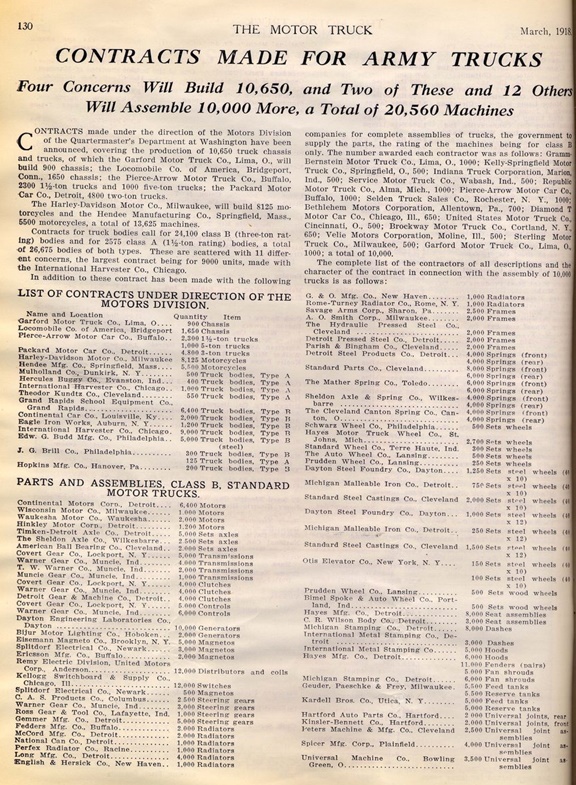
Document courtesy of Warren Richardson added
12-26-2020.
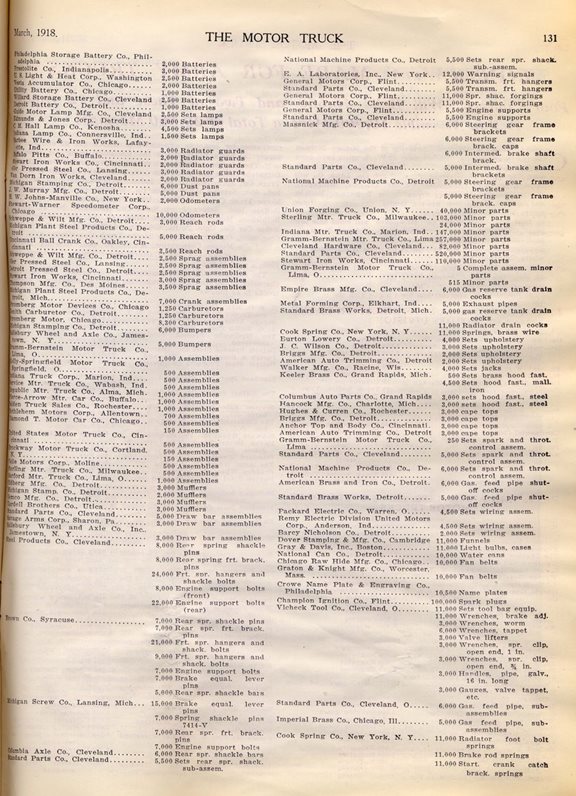
Document courtesy of Warren Richardson added
12-26-2020.
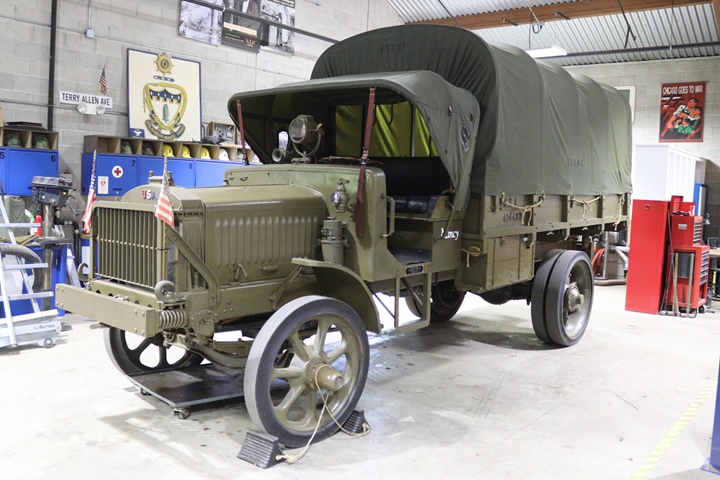
This
World War One Class B Liberty Truck has been restored to operating condition
by the First Division Museum in Wheaton, IL. The cape top over the
driver's seat is tied to the firewall with leather straps. Author's
photo added 12-26-2020.
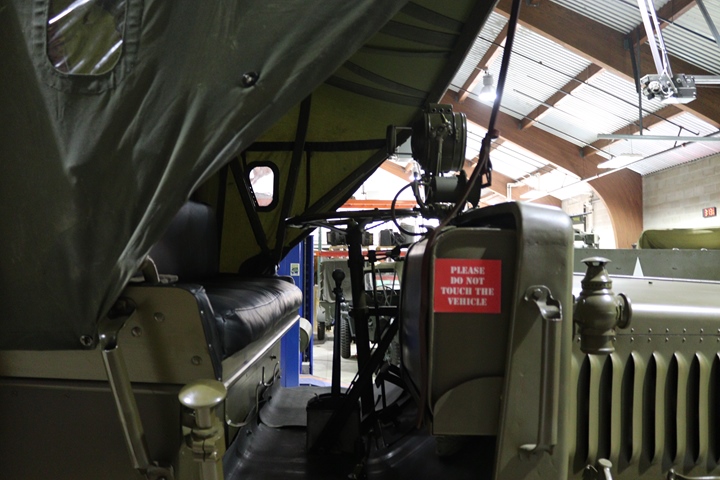
This photo shows the cape top in more
detail. The seat is leather. Author's
photo added 12-26-2020.
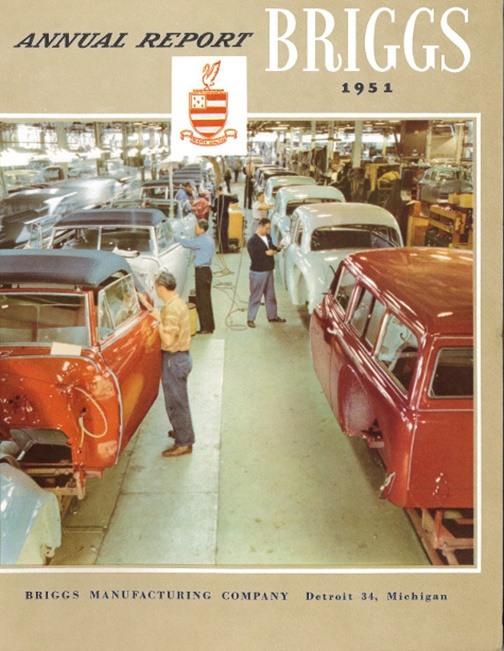
For those unfamiliar with the automotive
technology of the early auto industry, the car bodies were normally
assembled in a separate body plant, often by a different company than where the final assembly of the vehicle
took place.
This came about due to the way the auto industry evolved in Michigan.
Inventors like R.E. Olds and Henry Ford were most concerned with the
drive train and the mechanical aspects of the vehicle. The auto
makers turned to the former coach and wagon makers in Michigan for the
building of the passenger body. Prior to the coming of the
automobile as a dominant industry in 20th century Michigan,
the state had been home to a large coach industry. Therefore, many
of the former coach builders became the builders of the original wooden
bodies for the fledgling car companies. Later, the technology turned to
the steel bodies that are seen in the photo above.
The photo above shows a typical body line in
the trim shop that could have been in any one of many body manufacturers
at the time. The line on the left appears to be all convertibles,
while the one on the right has a station wagon with several sedan bodies on it. Once completed,
the bodies would be loaded on a truck and transported to the vehicle
assembly plant. When ready, the body would be mated to the chassis
in a body drop.
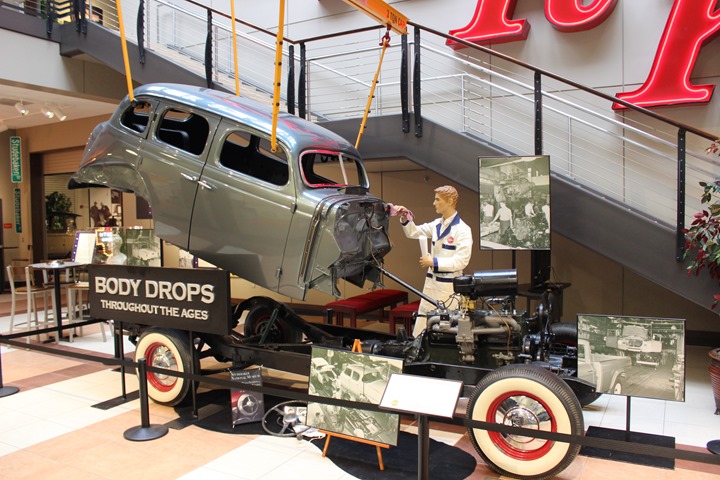
This former display at the Studebaker Museum
illustrates the body drop. The body manufacturers installed all of the
carpeting, seats, door hardware, and windows along with all of the
upholstery. While a person may have been driving a Chrysler
vehicle prior to 1954, he was sitting in a
Briggs-build body. Author's photo.
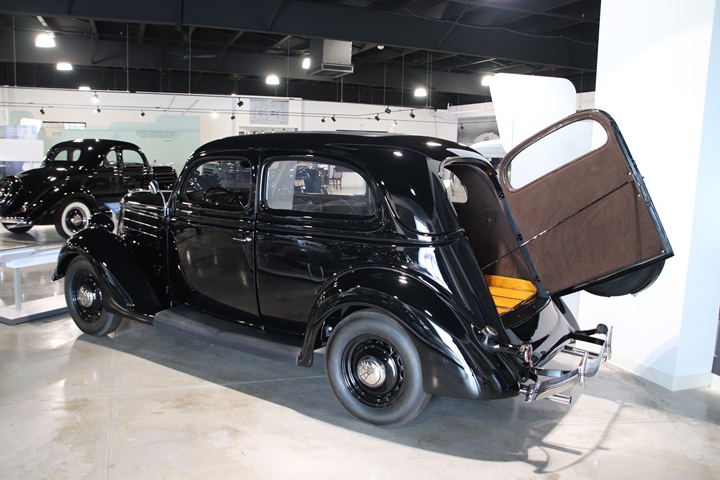
In 1935 Briggs Manufacturing converted 200
Ford sedans into Ford Deliveries. These may have been the first
SUVs. The back seats could be removed for a flat area for carrying
cargo. Author's photo from the Ford V-8 Museum in Auburn, IN.
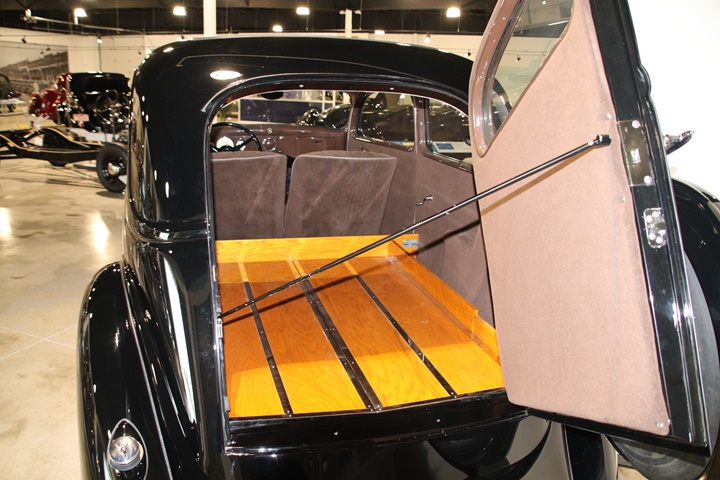
Author's photo.
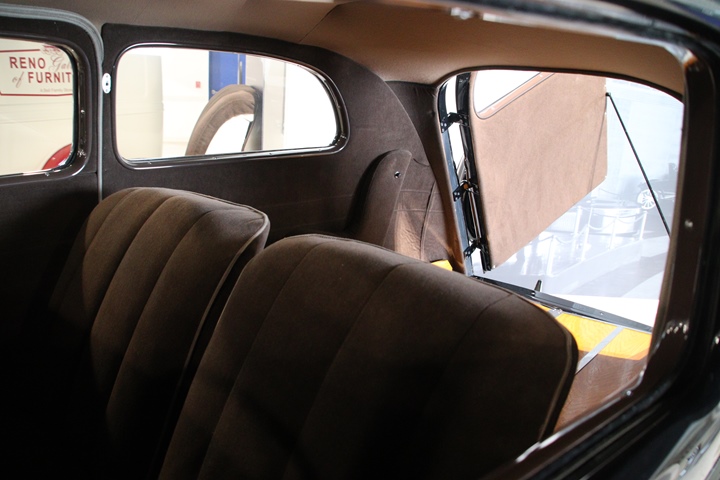
Briggs and other body manufacturers would
have huge stamping presses for all of the body parts which would be welded together in the body shop. The assembled body
then would be moved to the paint shop and then proceed to the trim shop,
where all the upholstery would be installed. The body
manufacturers would have entire departments, or even plants, that were
responsible for the building of the seats that went into the vehicles.
To me, growing up in Michigan in the 1950s,
Briggs meant Briggs Stadium where the Detroit Tigers played baseball.
Walter O. Briggs was sole owner of the Detroit Tigers from 1935
until his death in 1952. His son sold the Tigers in 1956. I was unaware until I
started working on this page that Briggs Stadium was connected to a Briggs Manufacturing
Company.
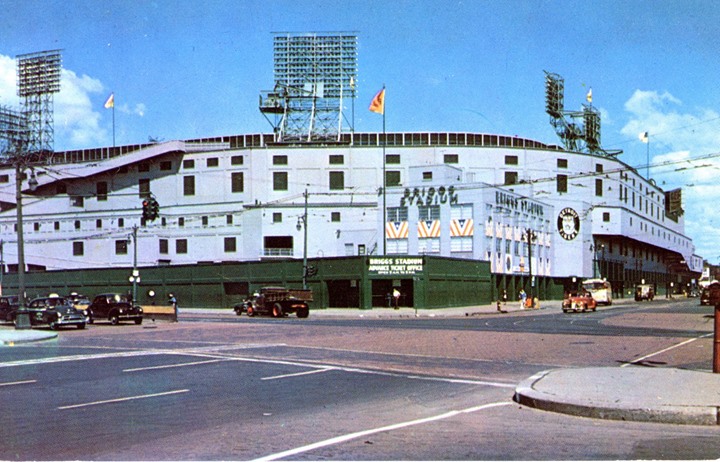
Back when I was in grade school, my father would take me once or twice
per summer to a Detroit Tiger's baseball game at Briggs Stadium in
Detroit. This was before the days of interstate travel. I still remember my dad
driving Grand River Avenue,
a three lane road. from Lansing to Detroit and back. The middle
lane was for passing. Each direction of travel had a specified
alternating section to pass in. It was not as dangerous as trying
to pass on a two lane highway of the era, but it still could make for
some exciting times trying to get around a vehicle before the passing
zone ended.
I still remember some of the Detroit Tiger
baseball players from the era: Al Kaline was the big hitter for
the team and local superstar of the era. He played in the outfield
with Charlie Maxwell and Harvey Kuenn. Who could forget Rocky
Bridges at third base, Chico Fernandez at short stop, Hank McAuliffe at
second base, and Norm Cash at first base? I guess if there were
ever "good old days," going to Briggs Stadium with my father to watch my
favorite Detroit Tigers baseball player would be them.
The Briggs Stadium, later renamed Tiger
Stadium, was torn down in 1999 and replaced by a new stadium with new
owners. It will always be Briggs Stadium to me.
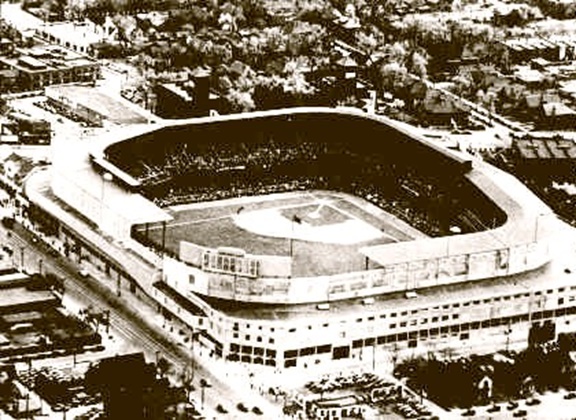
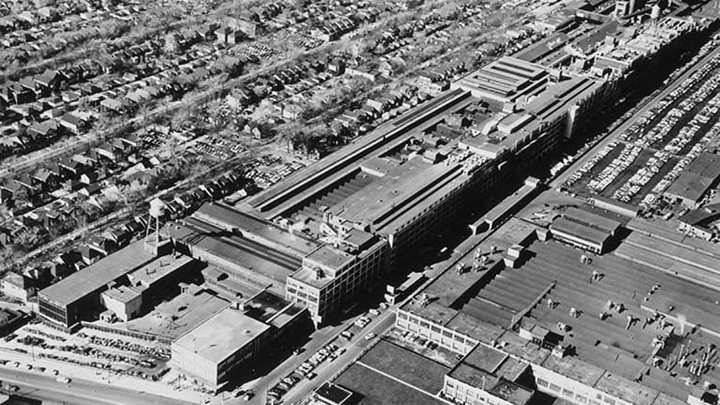
One of the Briggs Manufacturing Company's
main plants was at 11631 Mack Avenue in Detroit. It still exists
today as Chrysler's Mack Avenue Plant. Engines were produced there until 2012.
The plant is currently undergoing renovation to produce the next
generation Jeep Cherokee.
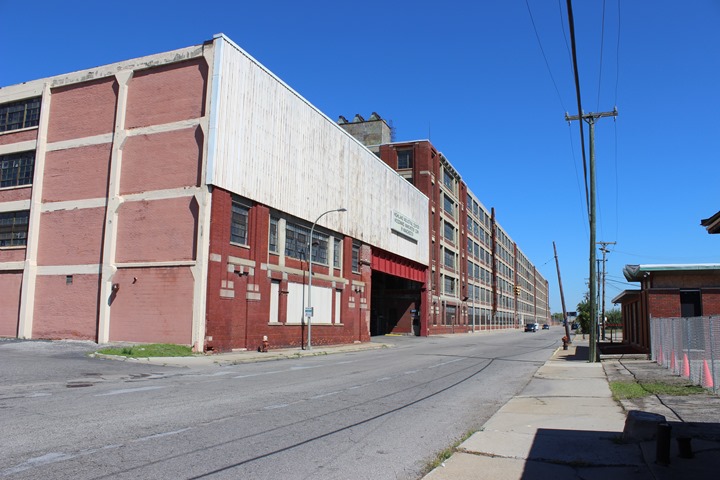
For several years, Briggs leased the former
Ford Highland Park Model T Plant when one of its plants was destroyed in a
fire. Briggs not only assembled Ford bodies in the plant, but
Chrysler bodies also. During World War Two, Ford built M4A3 Sherman
tanks and M10A Wolverine tank destroyers in the plant.
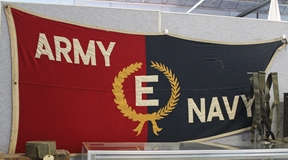
Briggs Manufacturing received the Army-Navy
"E" Award two times.
Briggs Manufacturing Company World War Two Military
Products: Briggs
Manufacturing Company had $173,559,000 in major war contracts during
World War Two from the U.S. Army and the U.S. Navy. Of the total
amount, $130,407,000 was for aircraft turrets for Army Air Force
multi-engine bombers. This was 75% of the total amount of major
contracts the company received. The first contract for aircraft
turrets was issued January 1942 and the last one was issued June 1944
and was completed in July 1945. Briggs Manufacturing was an
important suppler of aircraft turrets for the Army Air Force.
$4,074,000, or 2.3% of the
contracts were from the U.S. Navy.
The company also received a vast amount of
subcontracts from several aircraft manufacturers for airframe
components. These companies included Douglas, Goodyear, Grumman,
Martin, and Vought.
The 31,000 persons who worked at Briggs
Manufacturing Company during the war produced a multitude of components
to help win World War Two. It also made B-29 landing gear and bomb
bay doors, B-29 elevators, B-29 flaps, B-29 engine cowl sections,
and B-29 rudders. In 1945 it built 3,500 Knock-Down WC-64
ambulance bodies.
Briggs Indiana Corporation: This
body plant in Evansville, IN did final assembly on wings for several
Navy aircraft. Many, if not all of the components were fabricated
in the Detroit plant and shipped to Evansville for final assembly.
At the end of the war the Evansville plant had 4,000 employees making
wings for the FG-1 Corsair.
Table 1 - Briggs Manufacturing Company's
Major World War Two Contracts
The information below
comes from the "Alphabetical Listing of Major War Supply
Contracts, June 1940 through September 1945." This was
published by the Civilian Production Administration, Industrial
Statistics Division. This table added 5-6-2022. |
|
Product - Customer |
Contract Amount |
Contract Awarded
Date |
Completion
Date |
| Gun Turret
Assemblies - Army |
$29,912,000 |
1-1942 |
1-1943 |
| Cases
Cartridge - Army |
$5,248,000 |
1-1942 |
1-1942 |
| Model Engines
- Navy |
$55,000 |
6-1942 |
3-1943 |
| Tools - Army |
$8,603,000 |
7-1942 |
3-1943 |
| Turret
Assemblies - Army |
$133,000 |
7-1942 |
10-1942 |
| Cups - Army |
$995,000 |
8-1942 |
9-1943 |
| Gun Turret
Assemblies - Army |
$26,690,000 |
8-1942 |
11-1943 |
| Gun Turret
Assemblies - Army |
$10,226,000 |
9-1942 |
9-1943 |
| Training
Services - Army |
$519,000 |
10-1942 |
6-1944 |
| Cases
Cartridge - Army |
$1,204,000 |
10-1942 |
6-1943 |
| Tools Machine
Used - Army |
$104,000 |
11-1942 |
11-1942 |
| Welding
Equipment - Army |
$1,159,000 |
11-1942 |
5-1943 |
| Airpl Turret
Assemblies - Army |
$3,440,000 |
11-1942 |
3-1943 |
| Tools Machine
- Army |
$52,000 |
2-1942 |
3-1943 |
| Retraction
Mechanisms - Army |
$469,000 |
3-1943 |
5-1943 |
| Flame
Dampener Assys - Army |
$3,664,000 |
3-1943 |
12-1943 |
| Turret
Assemblies - Army |
$124,000 |
4-1943 |
4-1943 |
| Gun Turret
Assemblies - Army |
$12,561,000 |
5-1943 |
1-1945 |
| Droppable
Fuel Tanks - Navy |
$468,000 |
7-1943 |
9-1943 |
| Technical
Services - Army |
$120,000 |
8-1943 |
6-1945 |
| Droppable
Fuel Tanks - Navy |
$543,000 |
10-1943 |
12-1943 |
| Airplane
Turrets - Army |
$141,000 |
10-1943 |
11-1943 |
| Airplane
Parts - Army |
$150,000 |
10-1943 |
6-1944 |
| Fuel Tank
Assemblies - Navy |
$1,269,000 |
12-1943 |
5-1944 |
| Fuel Tanks -
Army |
$15,358,000 |
1-1944 |
5-1945 |
| Gun Turret
Assemblies - Army |
$2,556,000 |
1-1944 |
1-1944 |
| Airplane
Turrets - Army |
$9,818,000 |
1-1944 |
4-1945 |
| Dropbl Fuel
Tanks - Navy |
$1,026,000 |
1-1944 |
8-1944 |
| Airplane
Turrets - Army |
$70,000 |
2-1944 |
6-1945 |
| Gun Turret
Assys - Army |
$20,471,000 |
2-1944 |
4-1945 |
| Modify Gun
Turrets - Army |
$53,000 |
6-1944 |
10-1944 |
| Airpl Turret
Assys - Army |
$3,500,000 |
6-1944 |
3-1945 |
| Airplane
Turret Parts - Army |
$94,000 |
6-1944 |
4-1945 |
| Airplane
Turrets - Army |
$10,765,000 |
6-1944 |
7-1945 |
| Technical
Services - Navy |
$84,000 |
7-1944 |
6-1945 |
| Technical
Services - Navy |
$75,000 |
7-1944 |
6-1945 |
| Dropbl Fuel
Tanks - Navy |
$554,000 |
8-1944 |
8-1945 |
| Airplane
Turret Rprs - Army |
$90,000 |
12-1944 |
6-1945 |
| Cart Storage
Cases M13 - Army |
$781,000 |
1-1945 |
6-1945 |
| Rocket Band
Assemblies - Army |
$236,000 |
1-1945 |
3-1945 |
| Termination
Charges - Army |
$59,000 |
3-1945 |
8-1945 |
| Total |
$173,559,000 |
|
|
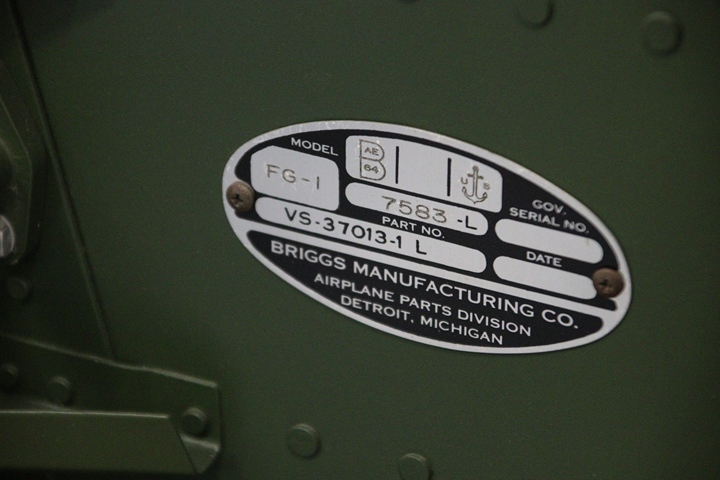
This Briggs Manufacturing Company data plate
is on a rebuilt wing for an FG-1 Corsair restoration at the Tri-State Warbird
Museum in Batavia, OH. The data plate appears to
be an unused example, and not the original that was on the wing.
However, this is an excellent example of a Briggs Manufacturing Company
data plate. Also, the data plate may only indicate that the
components were fabricated in Detroit, as Evansville, IN was the final
assembly point for the FG-1 wings. Author's photo.
Aircraft Gun Turrets:
Table 2 - Briggs Manufacturing Company's
Major World War Two Aircraft Gun Turret Contracts
The information below
comes from the "Alphabetical Listing of Major War Supply
Contracts, June 1940 through September 1945." This was
published by the Civilian Production Administration, Industrial
Statistics Division. This table added 5-6-2022. |
|
Product - Customer |
Contract Amount |
Contract Awarded
Date |
Completion
Date |
| Gun Turret
Assemblies - Army |
$29,912,000 |
1-1942 |
1-1943 |
| Turret
Assemblies - Army |
$133,000 |
7-1942 |
10-1942 |
| Gun Turret
Assemblies - Army |
$26,690,000 |
8-1942 |
11-1943 |
| Gun Turret
Assemblies - Army |
$10,226,000 |
9-1942 |
9-1943 |
| Airpl Turret
Assemblies - Army |
$3,440,000 |
11-1942 |
3-1943 |
| Turret
Assemblies - Army |
$124,000 |
4-1943 |
4-1943 |
| Gun Turret
Assemblies - Army |
$12,561,000 |
5-1943 |
1-1945 |
| Airplane
Turrets - Army |
$141,000 |
10-1943 |
11-1943 |
| Gun Turret
Assemblies - Army |
$2,556,000 |
1-1944 |
1-1944 |
| Airplane
Turrets - Army |
$9,818,000 |
1-1944 |
4-1945 |
| Airplane
Turrets - Army |
$70,000 |
2-1944 |
6-1945 |
| Gun Turret
Assys - Army |
$20,471,000 |
2-1944 |
4-1945 |
| Airpl Turret
Assys - Army |
$3,500,000 |
6-1944 |
3-1945 |
| Airplane
Turrets - Army |
$10,765,000 |
6-1944 |
7-1945 |
| Total |
$130,407,000 |
|
|
Sperry A2B Ball Turret for the B-17: This was the defensive
gun position in the belly of the B-17.
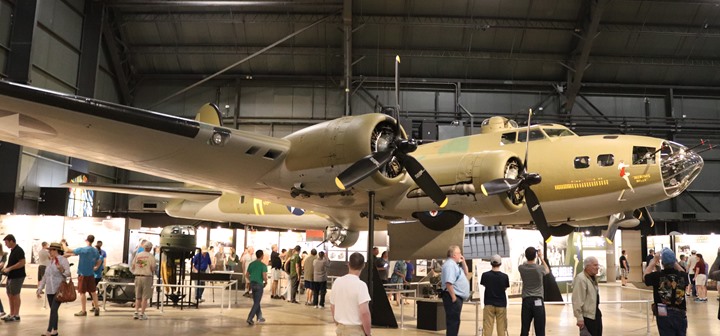
This is the B-17F Memphis Belle on display
at the National Museum of the United States Air Force. Author's
photo added 5-6-2022.
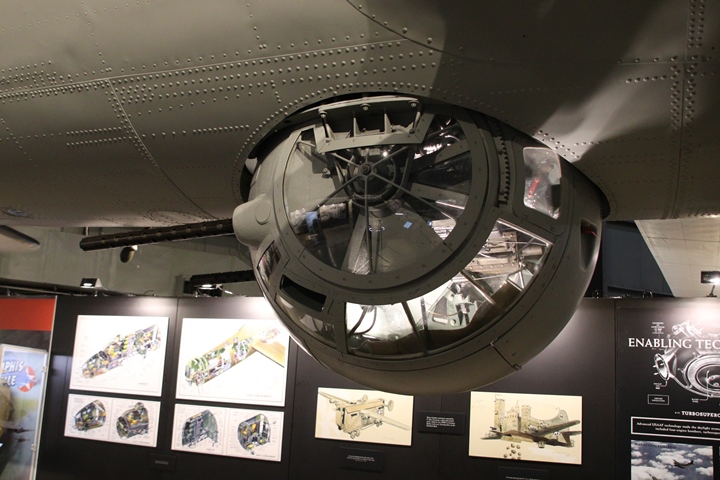
This is a Sperry A2B lower gun turret like
Briggs manufactured. Author's photo added 5-6-2022.
Sperry A13 Ball Turret for the B-24: This was the defensive gun position in the belly of the B-24. It
was located inside the aircraft during take-offs and landings. It
was then lowered once the aircraft took off.
There was not enough clearance for the aircraft to take-off or land with the turret
in the lowered position.
The following photos show two Sperry ball turrets at the National Museum
of the United States Air Force Dayton, OH. The first two photos
show them in the restoration area where they were being worked on.
The rest of the photos show one of them on display on the museum floor.
It is unknown whether Sperry, Briggs, or some other company built these.
The photos do show the detail and complexity of the turret.
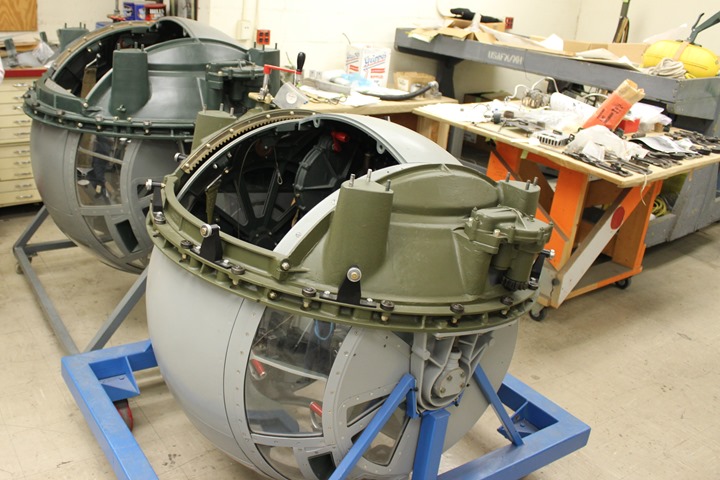
Author's photo.
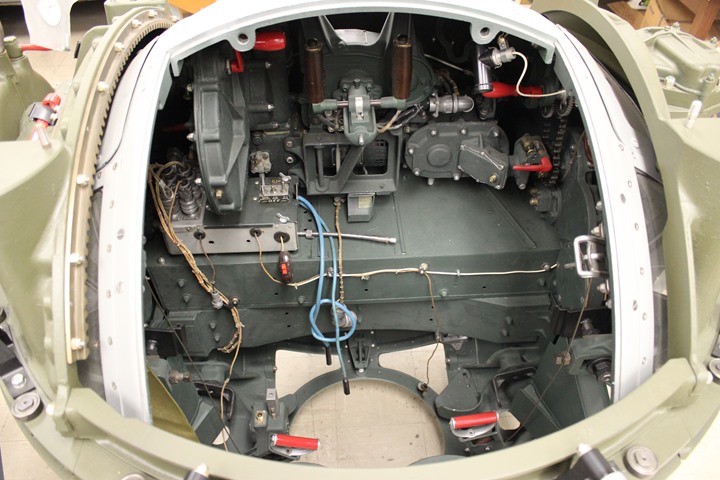
Author's photo.
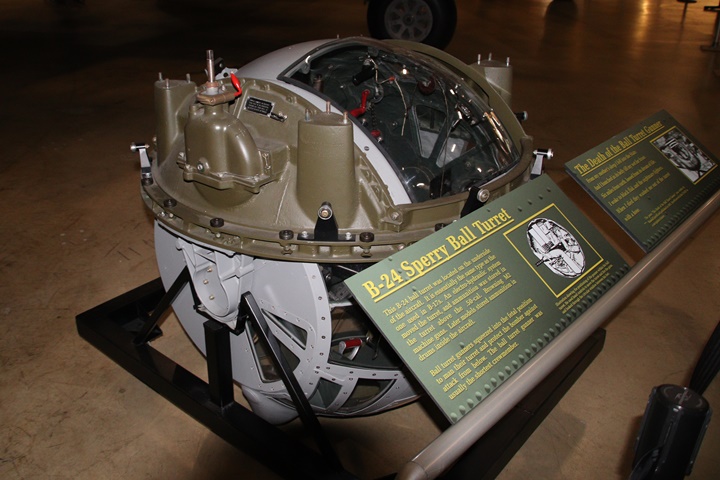
Author's photo.
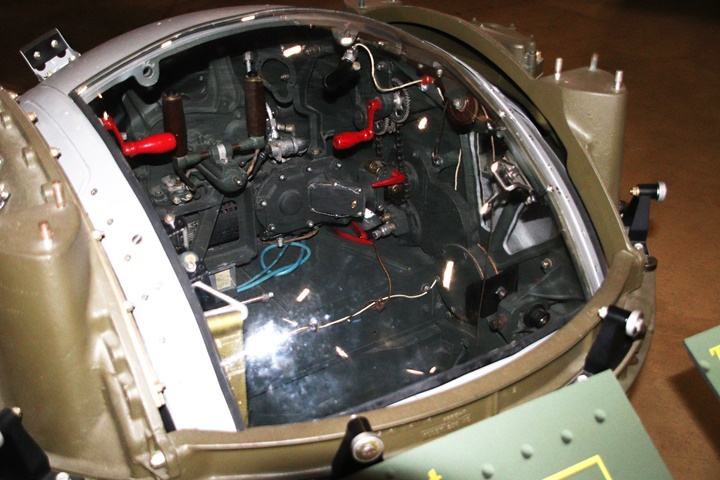
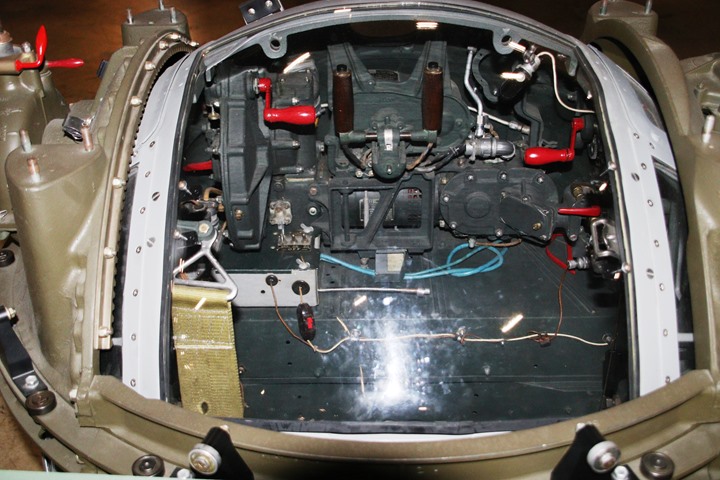
Looking all the way to the front of the
turret between the brown control handles is a data plate. Author's photo.
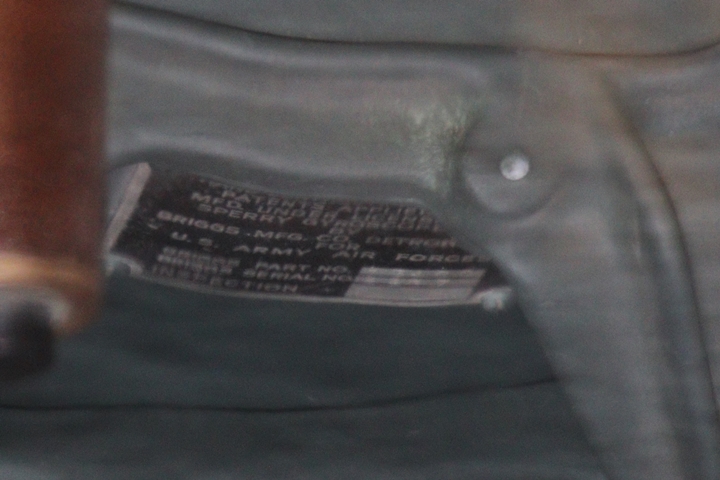
A 180 degree rotation of a close-up photo of
the data plate reveals that this turret was built by Briggs
Manufacturing Company. Author's photo added 5-6-2022.
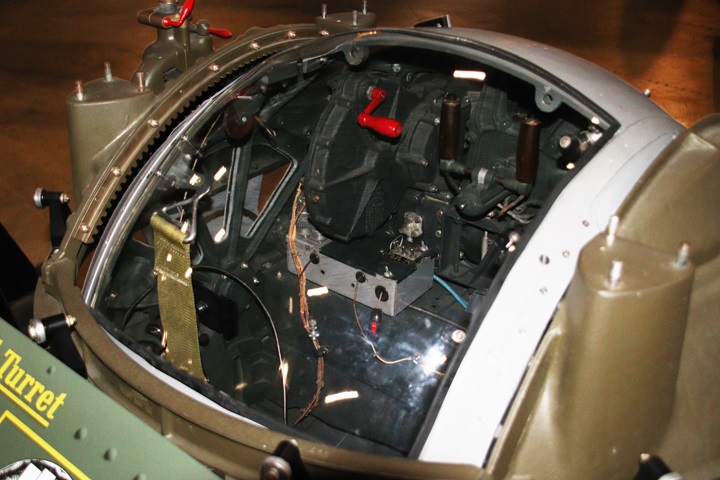
Author's photo.
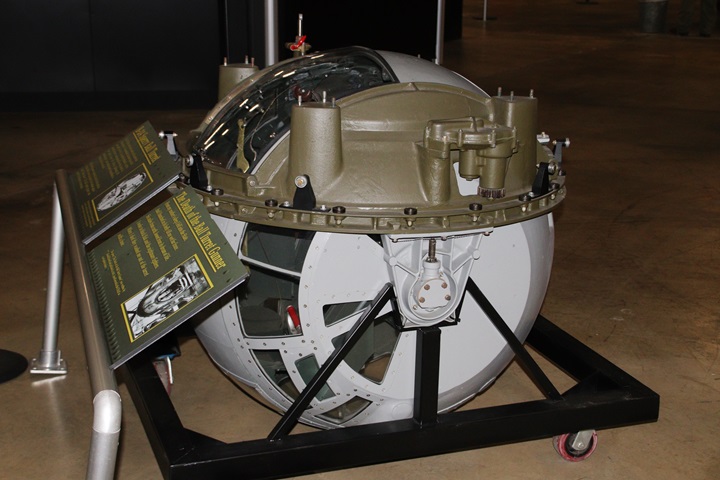
Author's photo.
Consolidated Tail Turret A-6 and A-6A -
Historical evidence shows that Briggs held training sessions for the
Consolidated tail turret. This implies that the company was also
building this turret for the B-24. Both the Sperry and
Consolidated turrets were installed in the B-24s being built by
Ford at Willow Run, MI.
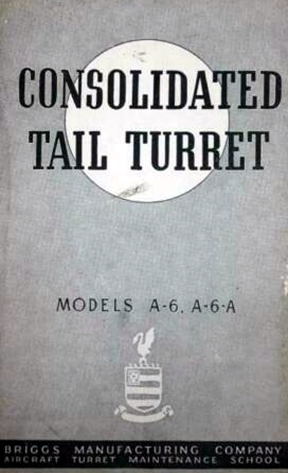
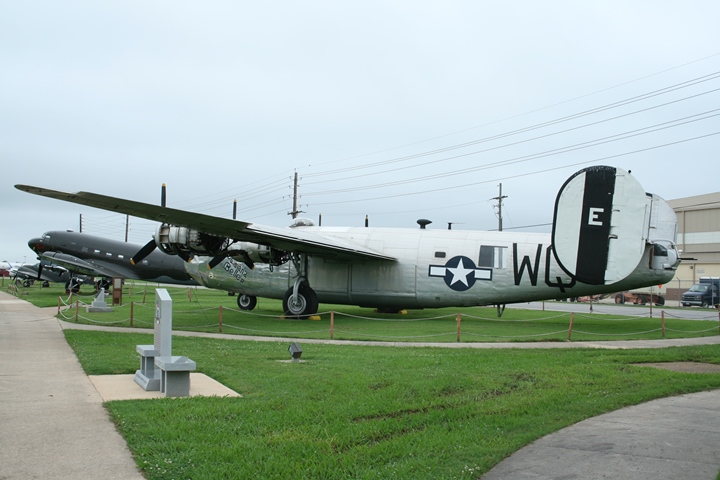
The Consolidated B-24 tail gun turret on this Ford-built B-24J
on display at the at the Barksdale Global Power Museum at Barksdale AFB
in Bossier City, LA looks very much like one in the photo above.
Ford built 6,790 B-24 at its Willow Run, MI plant outside of Detroit.
It was the nearest B-24 assembly plant to Motor Products Corporation.
Most likely Motor Products Corporation was the main supplier of A6 and
A6Arear
turrets to Ford. Author's photo added 5-6-2022.
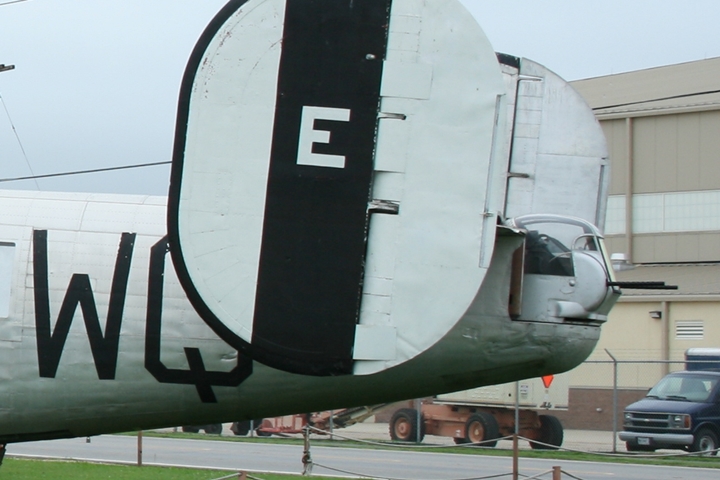
Author's photo added 5-6-2022.
Martin Upper Turret A-3 Series:
Historical evidence shows that Briggs held training sessions for the
Martin upper turret. This implies that the company was also
building this turret for the B-26.
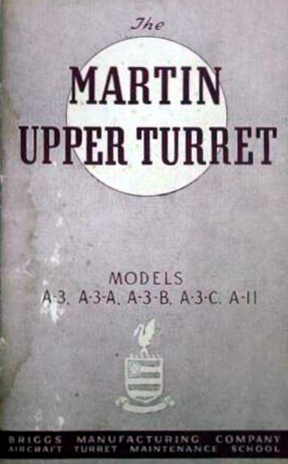
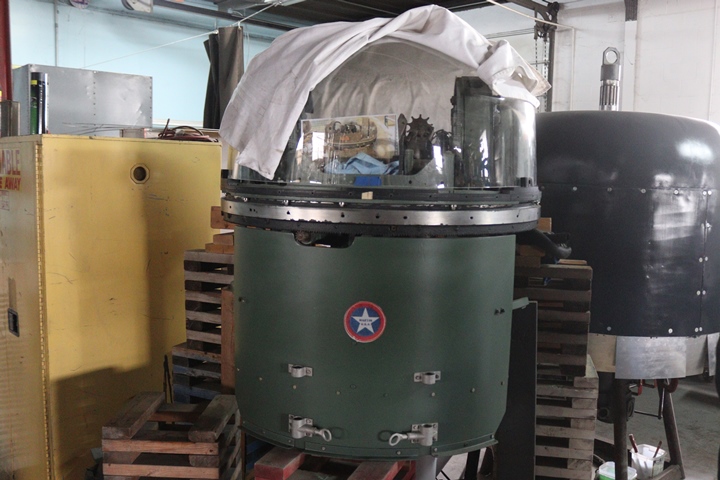
This Martin B-26 turret is under restoration
at the MAPS Museum in Canton, OH. It will be installed in the
museum's B-26. Author's photo added 5-6-2022.
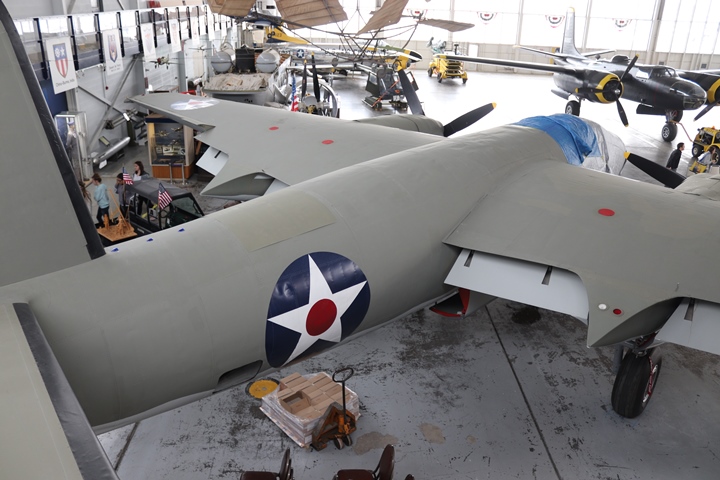
When fully restored, the turret will go in
the location of the patch on the aircraft. Author's photo added
5-6-2022.
Aircraft Components:
B-17G: Outer wings, wing tips, stabilizers, fins, ailerons,
flaps, ducts, ducting for air flow for the turbocharger system, and bomb bay
doors. Each bomb bay door used six
hundred parts and 5,400 rivets
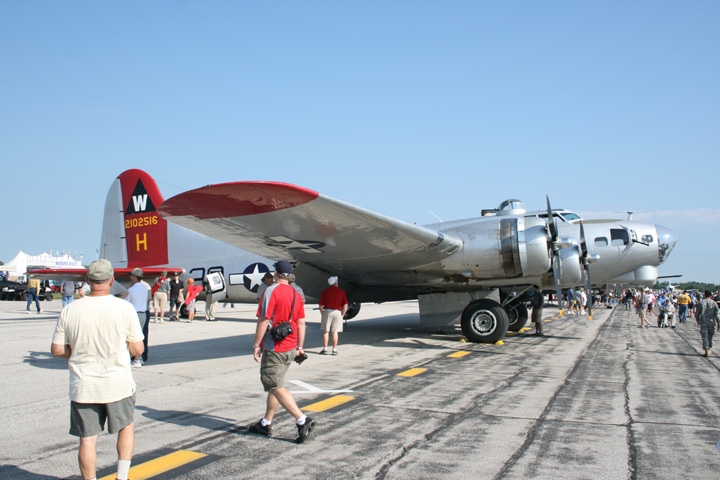
Author's photo.
A-20G: Outer wings, wing tips, ailerons
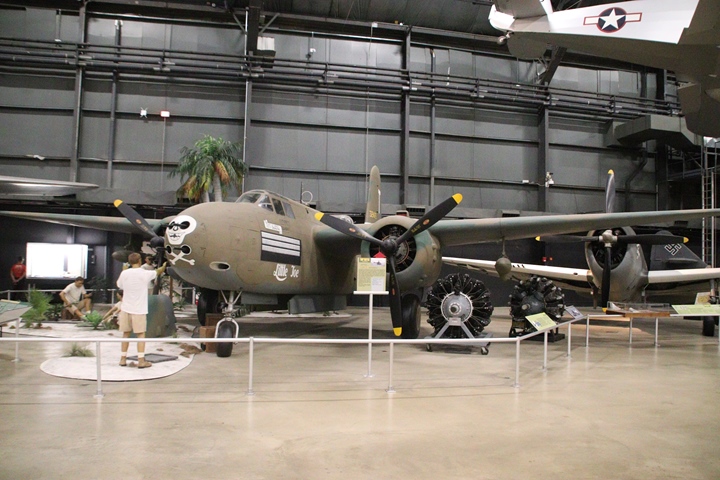
A Douglas A-20G on display at the National
Museum of the United States Air Force Dayton, OH. Author's photo.
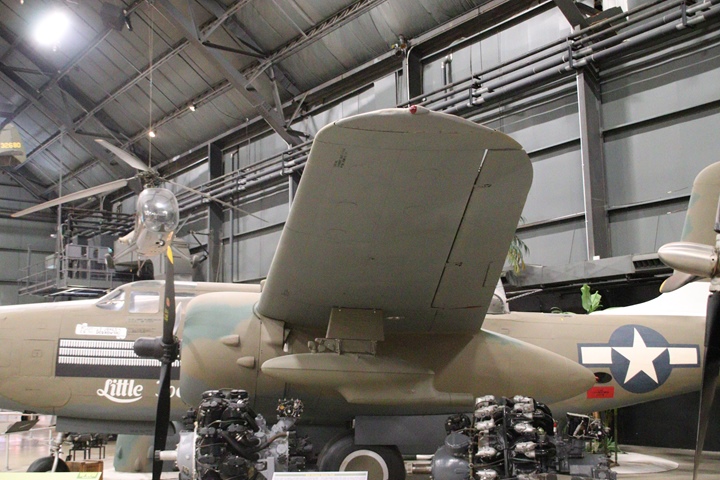
This photo shows the Briggs-built wing tip,
wing, and aileron. Author's photo.
B-26C: Bomb bay doors, bulkheads,
Martin top turrets
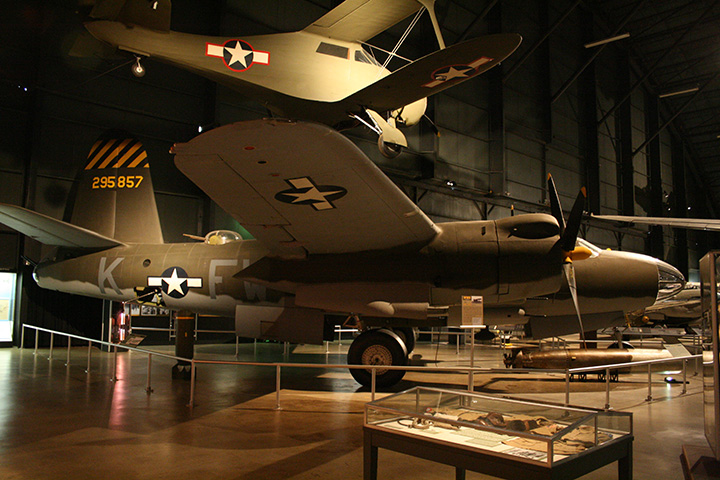
A Martin B-26 is on display at the National Museum
of the United States Air Force Dayton, OH. Author's photo.
B-29: Flaps, forward and aft bomb bay doors, nose wheel doors, outer
wings, dorsal fins, and stabilizers.
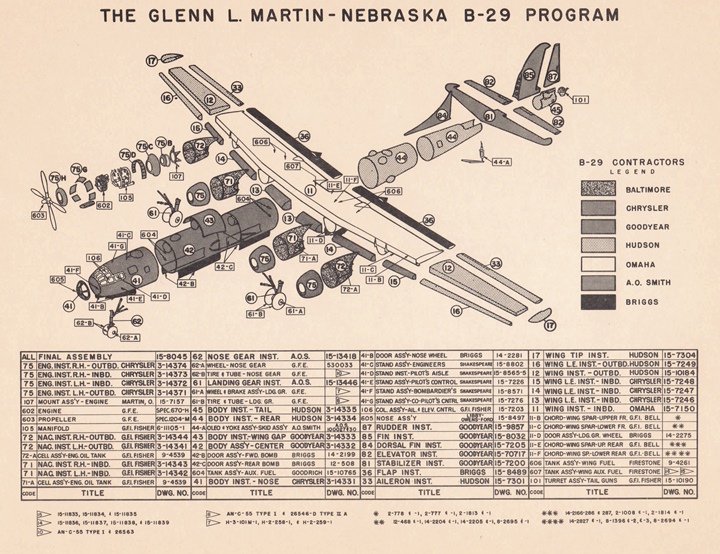
Briggs supplied the forward and rear bomb bay door assemblies, the nose
wheel door assemblies, the main landing gear door assemblies, and the
flaps to the Martin B-29 plant in Omaha, NE. The Omaha B-29 plant
built and modified all of the B-29s that were designated to carry the
new atomic bomb. Briggs Manufacturing-built B-29 components were
on the aircraft that bombed Hiroshima and Nagasaki.
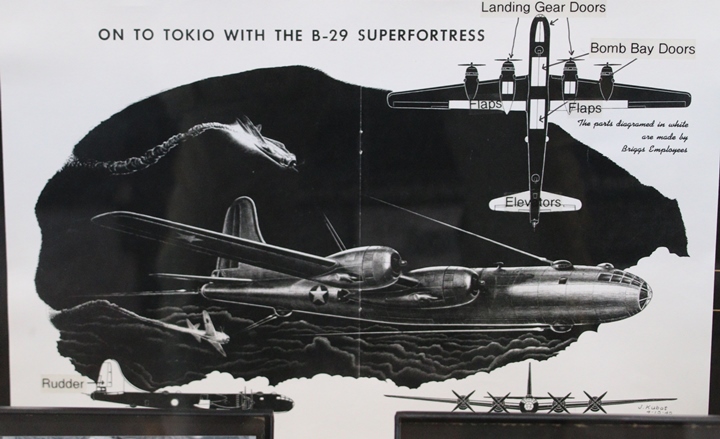
This World War Two Briggs document indicates
that the company was also building B-29 elevators and rudders.
There were three other final assembly plants besides the Martin plant in
Omaha, NE that produced the B-29 that Briggs could have supplied these
airframe components to. Image added 5-6-2022.
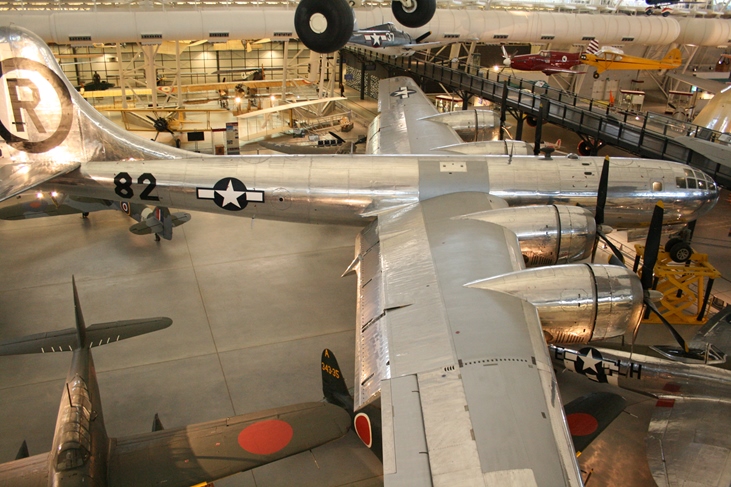
This is the Enola Gay at the Udvar-Hazy Center at Dulles Airport in
Virginia. The Briggs-built flaps can be seen in the down position
along the rear of the wings. Author's photo.
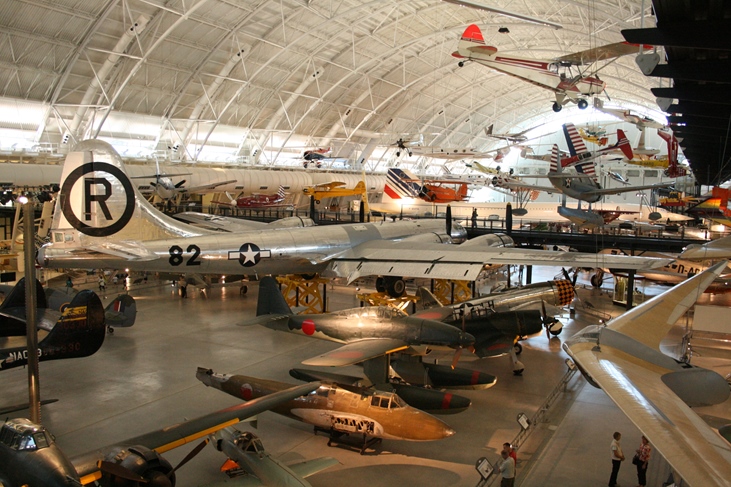
This photo gives a view of the starboard
side flap from the rear. The flap is almost as long as the P-47
underneath it. Author's photo.
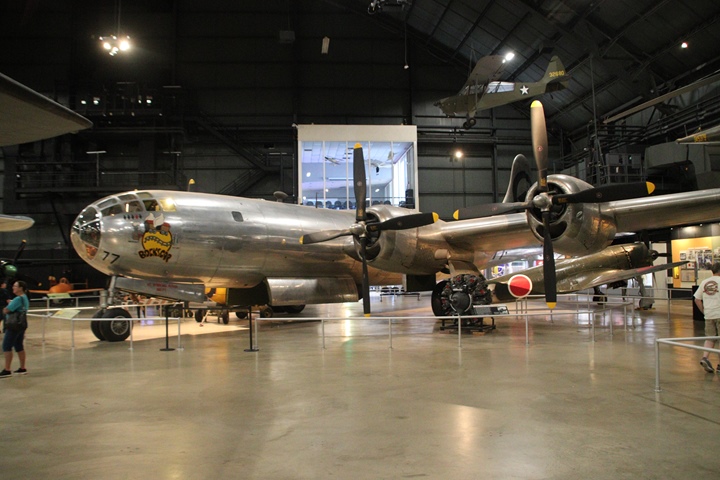
This is the B-29 "Bockscar" that dropped the
second atomic bomb in World War Two and is on display at the National
Museum of the United States Air Force. In this photo, the
Briggs-built nose gear doors and forward bomb bay doors can be seen.
Author's photo.
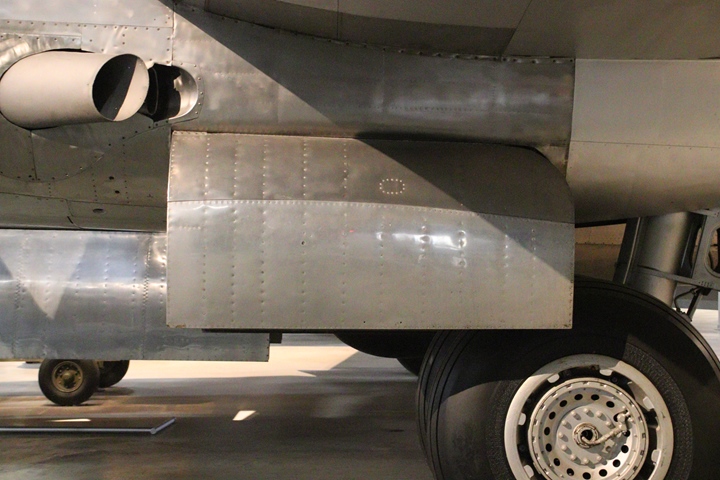
This shows the rivet pattern on the exterior
of the Briggs-built main gear door. Author's photo.
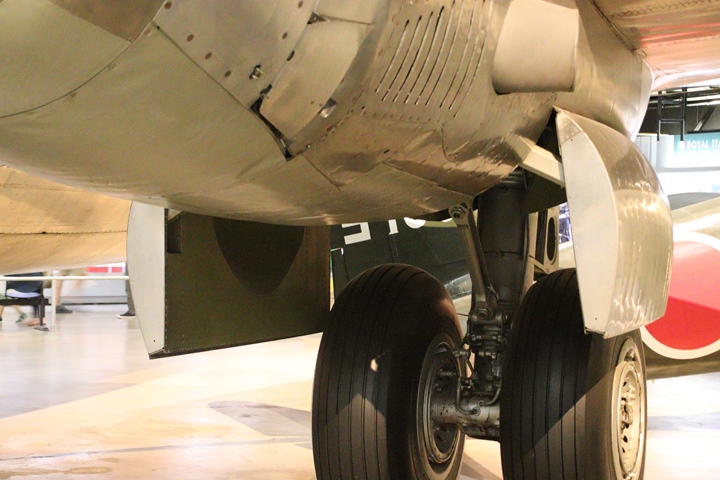
The inside of the main gear door was also covered with aluminum.
Author's photo.
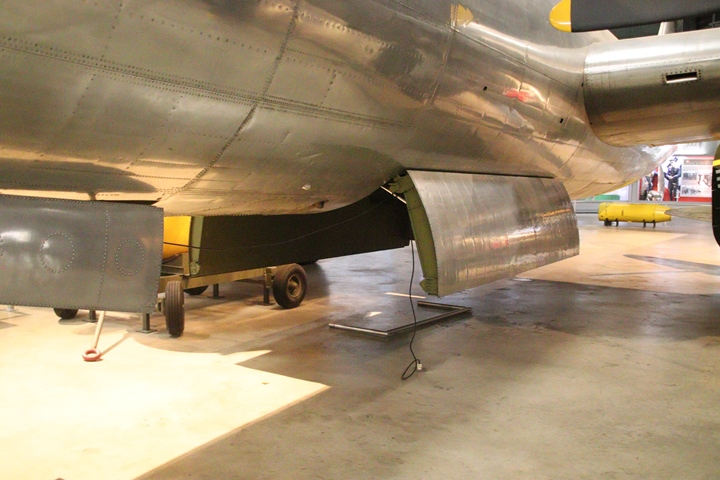
This is a close-up photo of the forward bomb
bay doors. Author's photo.
OS2N-1: Wings
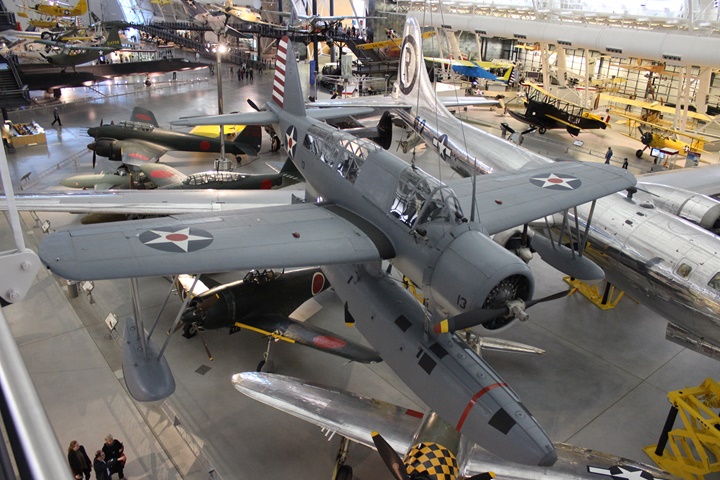
In 1942 Briggs supplied 300 sets of wings for the
Naval Aircraft Factory's version of the Vought OS2U Kingfisher.
This OS2U-3 is on display at the Udvar-Hazy Center of the National Air
and Space Museum. There are no surviving Naval Aircraft
Factory-built OS2N-1s still in existence. Author's photo added
9-29-2021.
FG-1: Wings
The FG-1 wing components appear to have been
built in the Detroit plant and then assembled by Briggs Indiana
Corporation in Evansville, IN. The data plate below specifically
denotes that the associated wing was built by the Airplane Parts
Division of Detroit, MI.
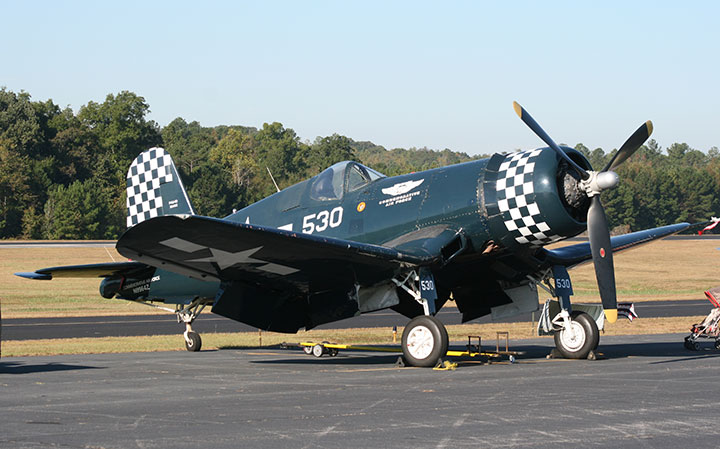
The Vought F4U Corsair was flown by the U.S. Navy and USMC. Goodyear built the Corsair under license
as the FG-1. Author's photo.
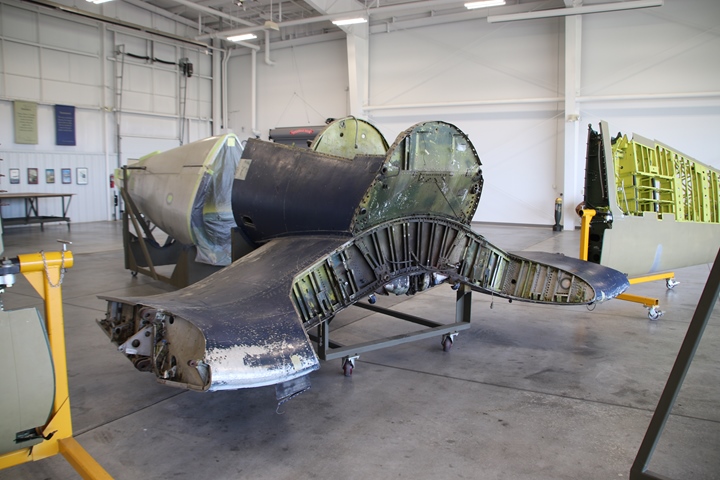
This Corsair is in long-term restoration at
the Tri-State Warbird Museum in Batavia, OH. The wing in the
background has the Briggs data plate on it. Author's photo.

This photo shows that Briggs was building
wings for Goodyear of Akron, OH. It stands to reason, as both were part
of the auto industry. If
Briggs built all of the wings for the Goodyear FG-1s, it would have
been able to provide 4,007 wing sets. Author's photo.
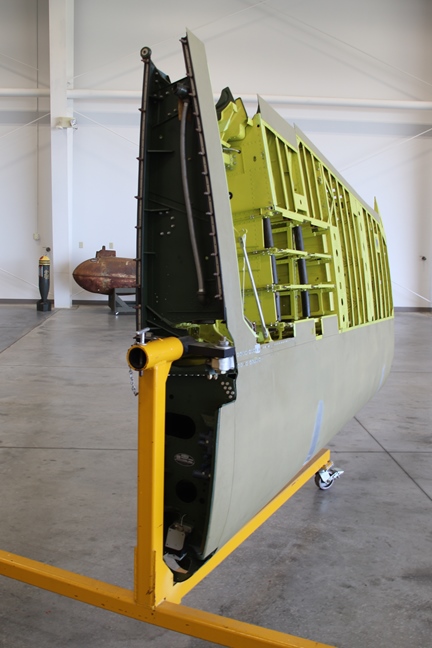
The data plate can be seen about one-third
of the way up in the wing end. Author's photo.
Aircraft Drop Tanks: Briggs had
four contracts from the Navy and one from the Army Air Force for
disposable drop tanks.
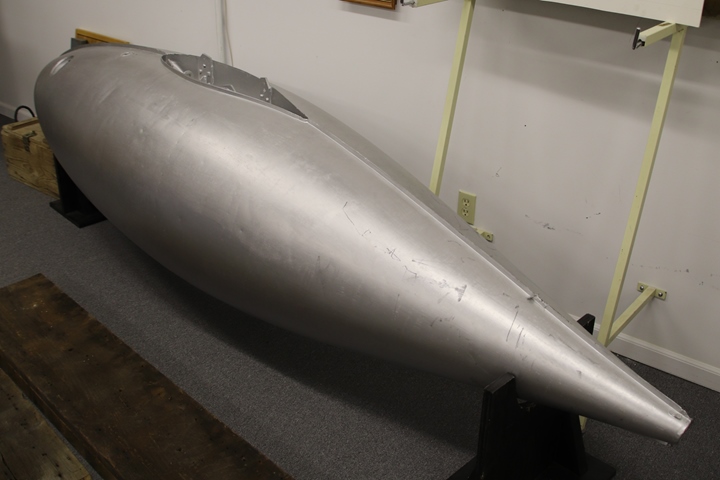
The drop tanks Briggs made would have been
similar to this. Author's photo added 5-6-2022.
Truck body parts: Unspecified cabs, tops, and ambulance bodies
- Dodge was the primary builder of military ambulances during World War
Two.
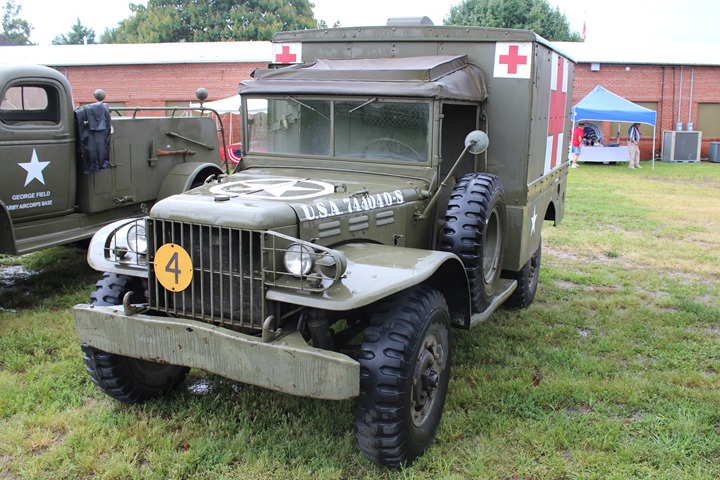
The WC-64 was the Army's replacement for the
WC-54. The concept was to provide a field ambulance that did not
take as much room to ship overseas. The steel cab of the WC-54 was
replaced with a fold-down windshield and canvas roof. Briggs
developed the ambulance body that was shipped as a knock-down.
When it arrived in the theater of operations, the ambulance body was
assembled. With this configuration, more WC-64s could be stacked
inside a ship's cargo area. Briggs built 3,500 of these in
1945. Author's photo added 10-27-2020.
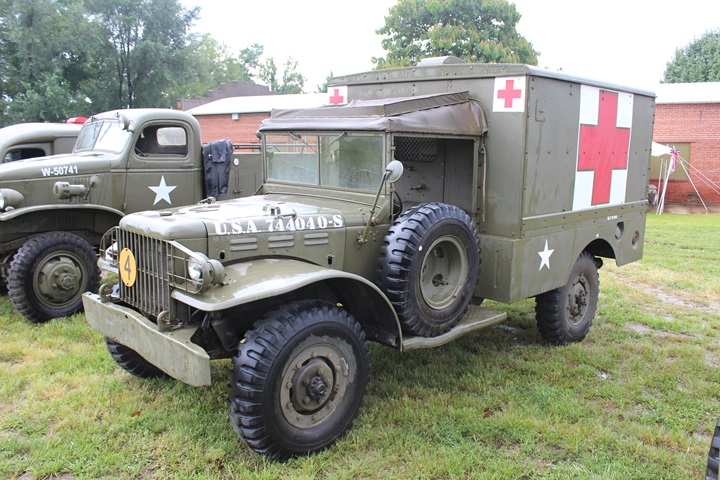
This is the only WC-64 I have found to
date. The WC-64 arrived too late to serve in World War Two.
It was provided extensively to American allies after World War Two.
This rare example was on display at the Indiana Military Museum's 2014
World War Two Days. The Briggs design had a wider body which
allowed for easier loading and unloading of litter patients that the
previous WC-54. Author's photo added 10-27-2020.
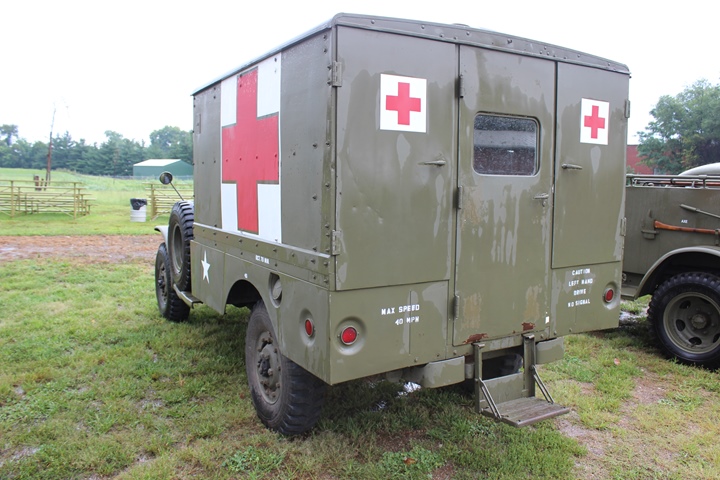
Author's photo added 10-27-2020.
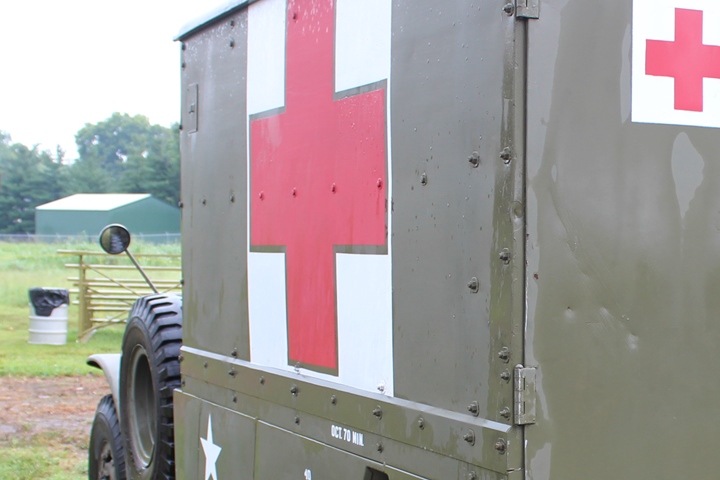
The Briggs design used threaded fasteners to
assemble the body. Author's photo added 10-27-2020.
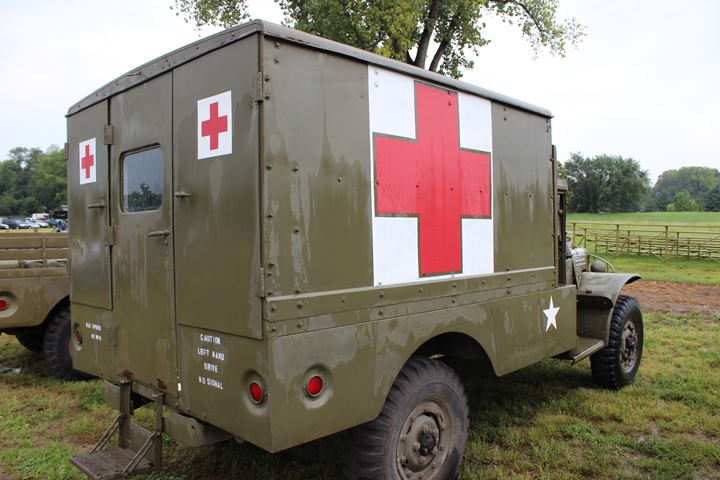
Author's photo added 10-27-2020.
M26 Pershing Heavy Tank: Tank hulls (90mm and 105mm models)
- The historical record shows Briggs making M26 tank hulls during the
war. This does not make sense, as this does not fit into the company's specialized
expertise. It stamped out sheet metal and then welded or riveted it
together for automobile, truck bodies, or aircraft parts.
Fabricating tank hulls would have required a foundry operation which
would have been considerably outside the expertise and experience of the
company.
There is nothing in the historical record that indicates the Briggs
Manufacturing Company ever purchased or operated a foundry. If it
actually did get into the foundry business, the hulls would have been for the Chrysler Tank Arsenal, as they included
hulls for the 105mm howitzer version. Only Chrysler built this
model. Also, Chrysler was Briggs most important non-war customer.
Chrysler eventually purchased Briggs in 1954.
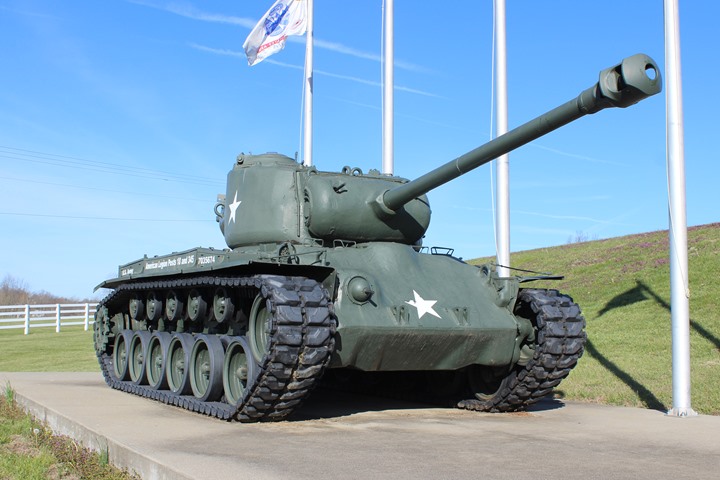
This is a Chrysler-built M26 Pershing.
The manufacture of the hull was outside the specialized expertise of the
Briggs Manufacturing Company. Author's photo.
Briggs Motor Bodies, Ltd. in the United
Kingdom during World War Two: Briggs had two plants in England
during World War Two. One was at Dagenham and the other at
Doncaster. Briggs was in the U.K. initially to supply bodes to the
local Ford Motor Company plant. It also produced bodies for
Austin, Chrysler and others. During World War Two Briggs in the
U.K. manufactured at a minimum steel helmets and jerry-cans.
Briggs Indiana Corporation: This
plant was located in Evansville, IN to provide bodies for the Chrysler
Plymouth car assembly plant located there. During World War Two,
the Briggs Evansville plant assembled wings for the PBY, TBY, FG-1, and
F4F U.S. Navy aircraft.
This information was unknown to me until I
visited the Evansville War Time Museum in April 2022. The
information at the museum shows that many of the aircraft components
associated with the parent company's plant in Detroit were actually
assembled in Evansville. The production line photos of the Briggs
Evansville Corporation plant are from displays at the Evansville War
Time Museum.
Early in World War Two Briggs Indiana produced
wings for the Grumman F4F Wildcat. Production would not have
started until mid or late 1942 due to having to build the tooling.
Production of the F4F wings would have then run until mid 1942 when
Goodyear would have been ramping up production of the FG-1. Briggs
Indiana Corporation ended F4F wing production and started FG-1 wing
production. In March 1945, Briggs Detroit was supplying parts to
Evansville for the FG-1 and TBY. In August 1945, 4,000 Evansville
employees were assembling wings for the FG-1.
F4F Wildcat: Table 2 shows the
F4F Wildcat production starting in July 1942 and ending February 1943.
Briggs would not have been ready any sooner than July 1942 to build the
wings in order to tool for mass production. In March 1943, Grumman
stopped building the F4F when the Eastern Aircraft Division of General
Motors took over the production. Briggs built approximately 991
wing sets for the Grumman Wildcat.
|
Table 2 - Grumman F4F Wildcat Production |
| Date |
Quantity |
| 7-1942 |
100 |
| 8-1942 |
135 |
| 9-1942 |
127 |
| 10-1942 |
163 |
| 11-1942 |
197 |
| 12-1942 |
175 |
| 1942 Total |
897 |
| |
|
| 1-1943 |
38 |
| 2-1943 |
54 |
| 1942 Total |
94 |
| Grand
Total |
991 |
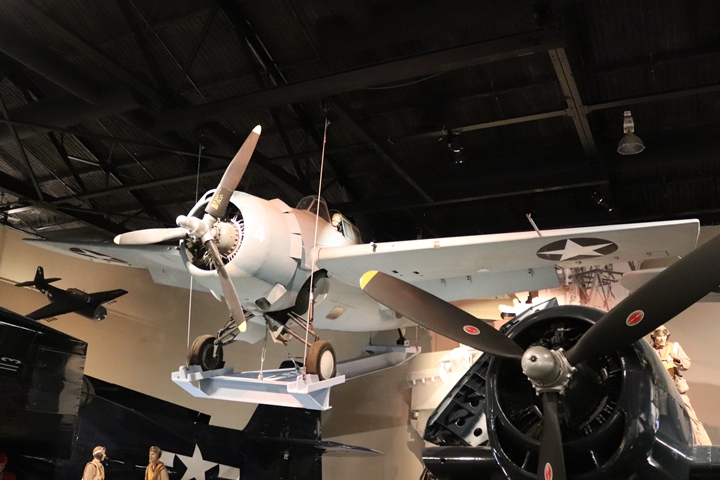
This F4F-3 with Briggs Indiana
Corporation-built wings is on display at the Cradle of Aviation Museum
in Long Island, NY.
Author's photo added 5-6-2022.
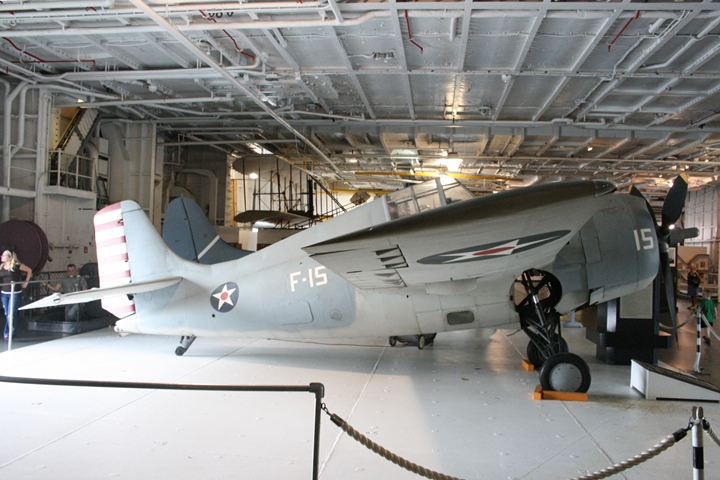
This F4F-3A is on display in the hangar deck
of the USS Yorktown at Patriots Point in South Carolina. The wings
were built in Evansville, IN by Briggs. Author's photo added
5-6-2022.
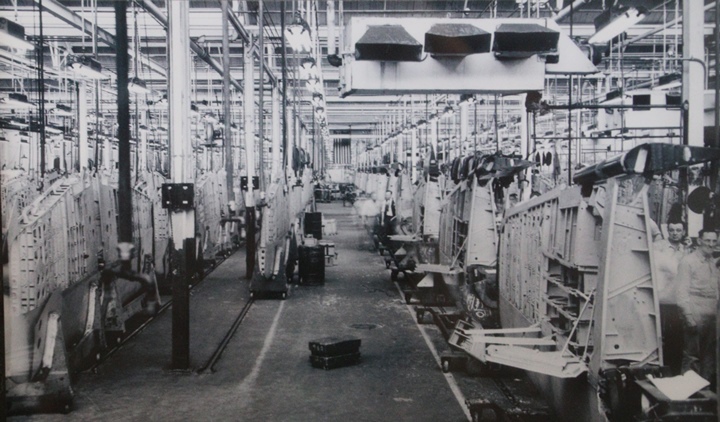
This photo shows the F4F wing assembly
lines. Image added 5-6-2022.
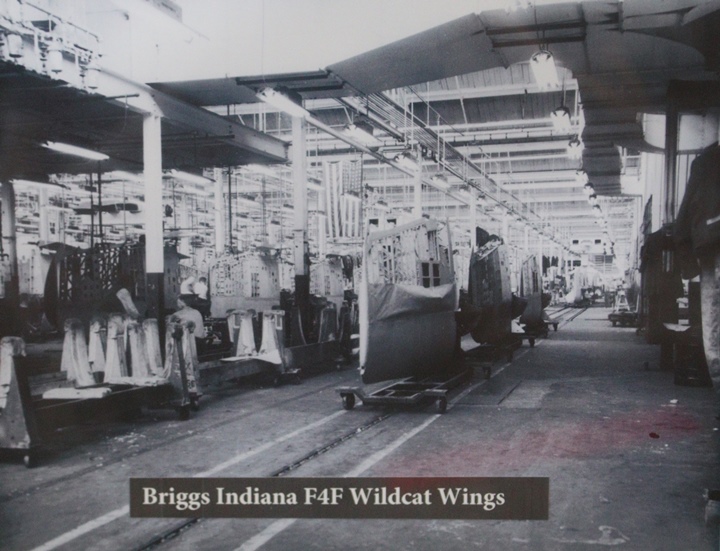
Grumman produced the F4F Wildcat series
aircraft until early 1943 when the Eastern Aircraft Division of General
Motors took over production as the FM-1 and FM-2. Image added
5-6-2022.
FG-1: In the 1945 Goodyear built
1,521 FG-1 Corsairs for the Navy. This averaged out to 190 wing
sets per month Briggs Indiana Corporation built to keep the Goodyear
production line running.
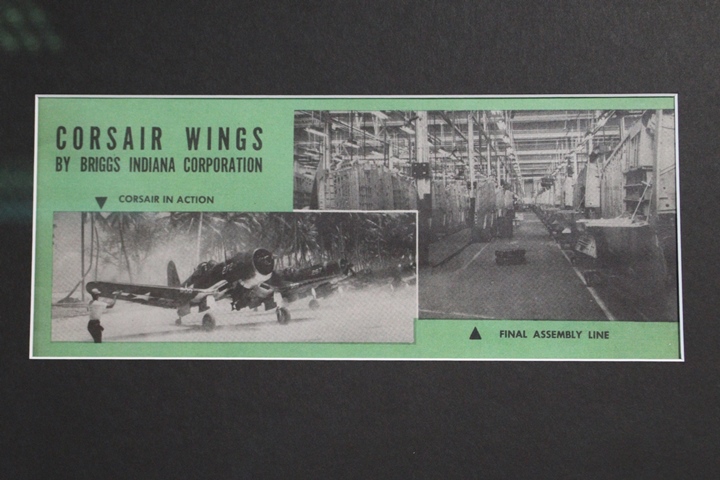
This image from a Briggs Indiana Corporation
Document shows the final assembly line for Corsair Wings. It
appears to be from the same location as the previous photo of the F4F
line. Image added 5-6-2022.
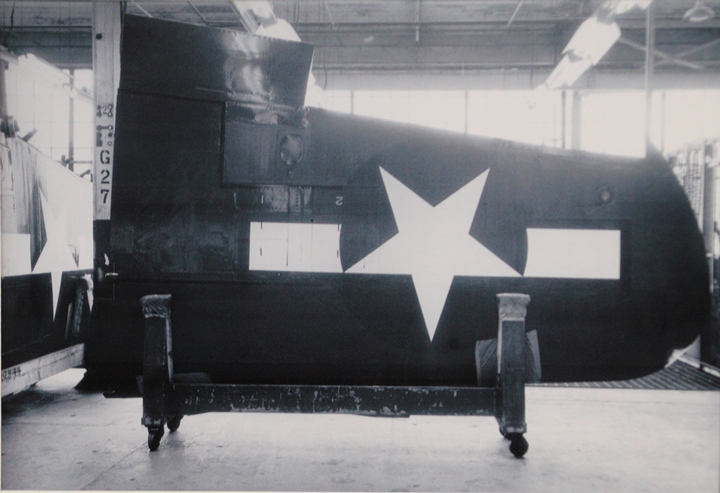
The Corsair wings were last product
made by the company in World War Two. Production continued until
the war ended in August 1945. Image added 5-6-2022.
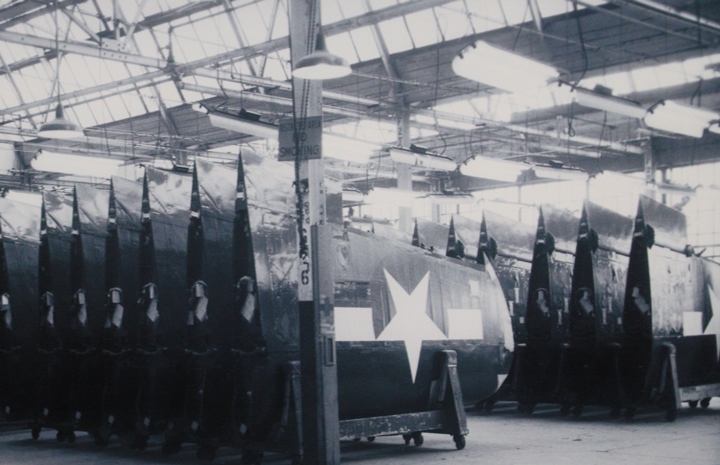
Image added 5-6-2022.
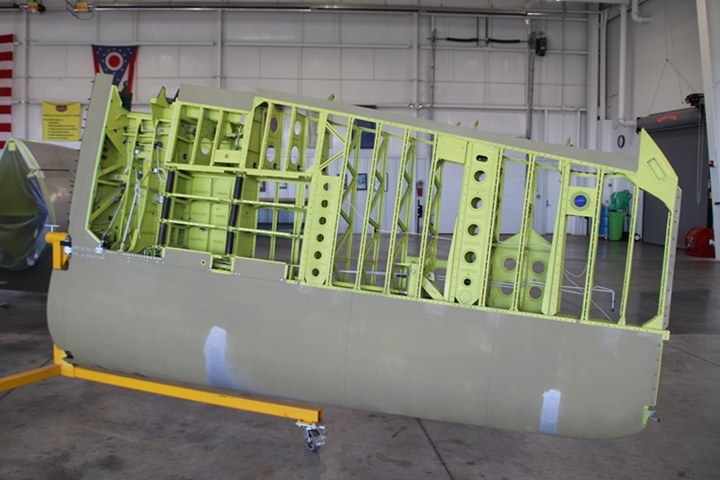
Author's photo added 5-6-2022.
TBY: Only 180
Consolidated TBYs were built in Allentown, PA during World War Two.
By the time the TBY went into production, the General Motors-built TBM
had established itself as an effective torpedo bomber, of which
sufficient quantities were available. Also, the U.S. Navy was
running out of Japanese naval targets to attack. Therefore, Briggs
Indiana Corporation only built wing sets for 172 TBY aircraft.
|
Table 3 - TBY Production |
| Date |
Quantity |
| 11-1944 |
1 |
| 12-1944 |
1 |
| 1-1945 |
8 |
| 2-1945 |
6 |
| 3-1945 |
11 |
| 4-1945 |
14 |
| 5-1945 |
20 |
| 6-1945 |
33 |
| 7-1945 |
31 |
| 8-1945 |
41 |
| Total |
174 |
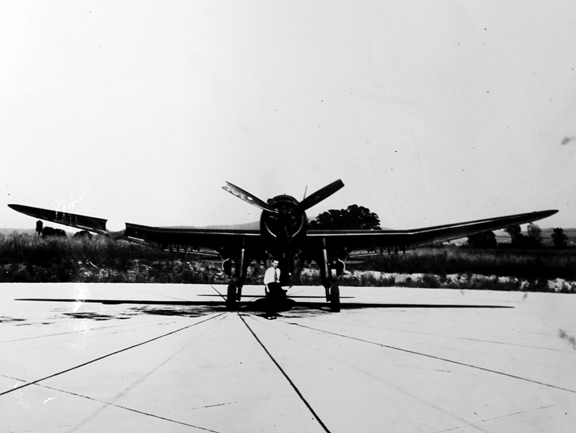
Photo courtesy of the Mack Museum.
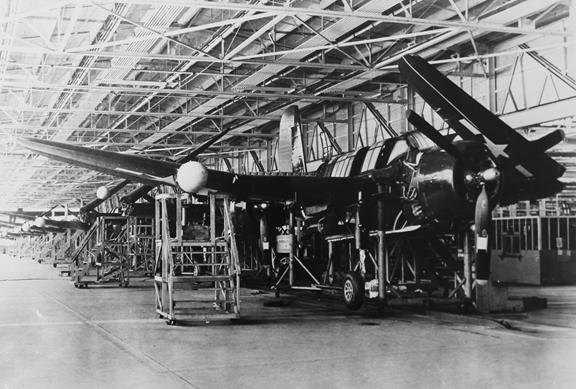
The folded wings on the TBYs coming down the production line show the
size of its wing in Allentown, PA with Evansville, IN-built wings. Photo courtesy of the Mack Museum.
PBY:
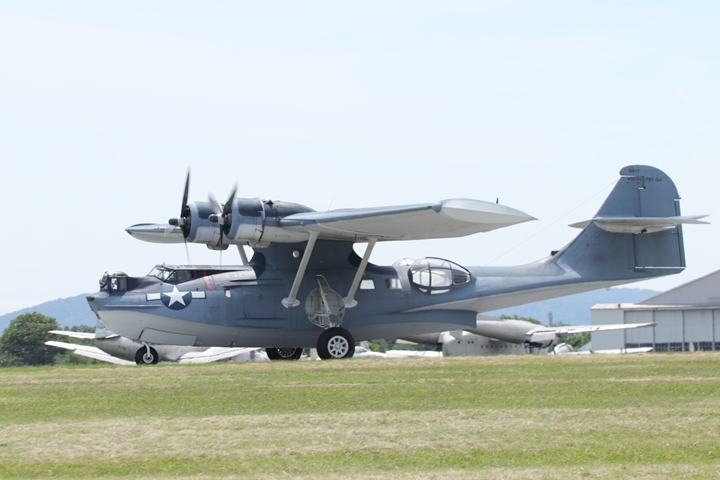
Briggs Indiana built an unknown number of
outer wing sections for the Consolidated PBY. Author's photo.
The Plant: The Briggs Indiana
Corporation was located at 830 East Columbia Street in Evansville, IN.
This was not far from the Plymouth plant for which it supplied bodies to
in peacetime. In 1954 the plant became part of Chrysler
Corporation when it purchased the Briggs Manufacturing Company of
Detroit.
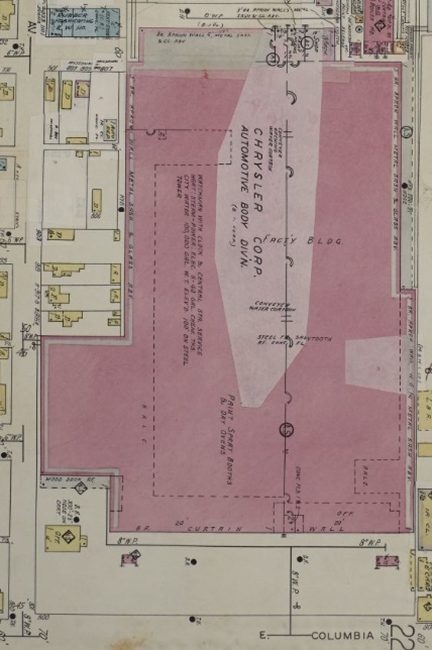
This 1962 Sanborn maps shows the 820 East
Columbia Street location of the former Briggs Indiana Corporation plant.
Image added 5-6-2022.
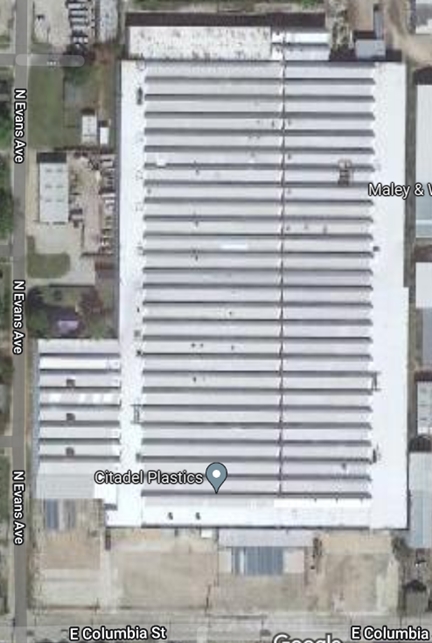
This Google Maps satellite image shows the
factory is still standing and in use today. Image added 5-6-2022.

Eighty years after the former Briggs Indiana
Corporation built wings for several U.S. Navy aircraft to help win World
War Two, the plant still looks good. Google Maps image added
5-6-2022.
|



































































